Magnet
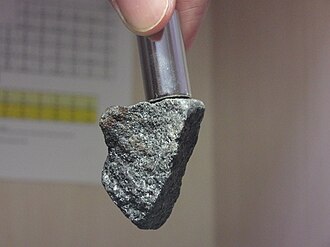
| Articles about |
| Electromagnetism |
|---|
 |
A magnet is a material or object that produces a
, etc. and attracts or repels other magnets.A permanent magnet is an object made from a material that is
Ferromagnetic materials can be divided into magnetically "soft" materials like
An
Discovery and development
Ancient people learned about magnetism from
In 11th century China, it was discovered that quenching red hot iron in the Earth's magnetic field would leave the iron permanently magnetized. This led to the development of the navigational compass, as described in Dream Pool Essays in 1088.[7][8] By the 12th to 13th centuries AD, magnetic compasses were used in navigation in China, Europe, the Arabian Peninsula and elsewhere.[9]
A straight iron magnet tends to demagnetize itself by its own magnetic field. To overcome this, the horseshoe magnet was invented by Daniel Bernoulli in 1743.[7][10] A horseshoe magnet avoids demagnetization by returning the magnetic field lines to the opposite pole.[11]
In 1820, Hans Christian Ørsted discovered that a compass needle is deflected by a nearby electric current. In the same year André-Marie Ampère showed that iron can be magnetized by inserting it in an electrically fed solenoid. This led William Sturgeon to develop an iron-cored electromagnet in 1824.[7] Joseph Henry further developed the electromagnet into a commercial product in 1830–1831, giving people access to strong magnetic fields for the first time. In 1831 he built an ore separator with an electromagnet capable of lifting 750 pounds (340 kg).[12]
Physics
Magnetic field
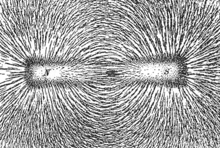
The magnetic flux density (also called magnetic B field or just magnetic field, usually denoted B) is a vector field. The magnetic B field vector at a given point in space is specified by two properties:
- Its direction, which is along the orientation of a compass needle.
- Its magnitude (also called strength), which is proportional to how strongly the compass needle orients along that direction.
In
Magnetic moment
A magnet's magnetic moment (also called magnetic dipole moment and usually denoted μ) is a
A magnet both produces its own magnetic field and responds to magnetic fields. The strength of the magnetic field it produces is at any given point proportional to the magnitude of its magnetic moment. In addition, when the magnet is put into an external magnetic field, produced by a different source, it is subject to a torque tending to orient the magnetic moment parallel to the field.[15] The amount of this torque is proportional both to the magnetic moment and the external field. A magnet may also be subject to a force driving it in one direction or another, according to the positions and orientations of the magnet and source. If the field is uniform in space, the magnet is subject to no net force, although it is subject to a torque.[16]
A wire in the shape of a circle with area A and carrying current I has a magnetic moment of magnitude equal to IA.
Magnetization
The magnetization of a magnetized material is the local value of its magnetic moment per unit volume, usually denoted M, with units
Modelling magnets
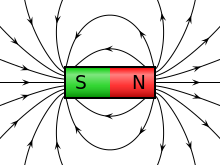
Two different models exist for magnets: magnetic poles and atomic currents.
Although for many purposes it is convenient to think of a magnet as having distinct north and south magnetic poles, the concept of poles should not be taken literally: it is merely a way of referring to the two different ends of a magnet. The magnet does not have distinct north or south particles on opposing sides. If a bar magnet is broken into two pieces, in an attempt to separate the north and south poles, the result will be two bar magnets, each of which has both a north and south pole. However, a version of the magnetic-pole approach is used by professional magneticians to design permanent magnets.[citation needed]
In this approach, the divergence of the magnetization ∇·M inside a magnet is treated as a distribution of magnetic monopoles. This is a mathematical convenience and does not imply that there are actually monopoles in the magnet. If the magnetic-pole distribution is known, then the pole model gives the magnetic field H. Outside the magnet, the field B is proportional to H, while inside the magnetization must be added to H. An extension of this method that allows for internal magnetic charges is used in theories of ferromagnetism.
Another model is the
Polarity
The north pole of a magnet is defined as the pole that, when the magnet is freely suspended, points towards the Earth's
Magnetic materials
The term magnet is typically reserved for objects that produce their own persistent magnetic field even in the absence of an applied magnetic field. Only certain classes of materials can do this. Most materials, however, produce a magnetic field in response to an applied magnetic field – a phenomenon known as magnetism. There are several types of magnetism, and all materials exhibit at least one of them.
The overall magnetic behavior of a material can vary widely, depending on the structure of the material, particularly on its electron configuration. Several forms of magnetic behavior have been observed in different materials, including:
- ferrimagnetic materials are the ones normally thought of as magnetic; they are attracted to a magnet strongly enough that the attraction can be felt. These materials are the only ones that can retain magnetization and become magnets; a common example is a traditional refrigerator magnet. Ferrimagnetic materials, which include ferrites and the longest used and naturally occurring magnetic materials magnetite and lodestone, are similar to but weaker than ferromagnetics. The difference between ferro- and ferrimagnetic materials is related to their microscopic structure, as explained in Magnetism.
- aluminum, and oxygen, are weakly attracted to either pole of a magnet. This attraction is hundreds of thousands of times weaker than that of ferromagnetic materials, so it can only be detected by using sensitive instruments or using extremely strong magnets. Magnetic ferrofluids, although they are made of tiny ferromagnetic particles suspended in liquid, are sometimes considered paramagnetic since they cannot be magnetized.
- Superconductorsrepel magnetic fields from their interior and are strongly diamagnetic.
There are various other types of magnetism, such as spin glass, superparamagnetism, superdiamagnetism, and metamagnetism.
Common uses
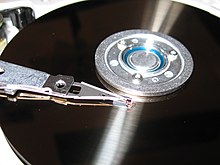
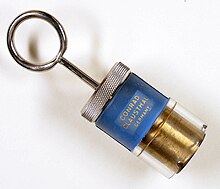
- Magnetic recording media: hard disks record data on a thin magnetic coating.[25]
- automatic teller machine cards: All of these cards have a magnetic strip on one side. This strip encodes the information to contact an individual's financial institution and connect with their account(s).[26]
- Older types of cathode ray tube employ an electromagnet to guide electrons to the screen.[27]
- Speakers and microphones: Most speakers employ a permanent magnet and a current-carrying coil to convert electric energy (the signal) into mechanical energy (movement that creates the sound). The coil is wrapped around a bobbin attached to the speaker cone and carries the signal as changing current that interacts with the field of the permanent magnet. The voice coil feels a magnetic force and in response, moves the cone and pressurizes the neighboring air, thus generating sound. Dynamic microphones employ the same concept, but in reverse. A microphone has a diaphragm or membrane attached to a coil of wire. The coil rests inside a specially shaped magnet. When sound vibrates the membrane, the coil is vibrated as well. As the coil moves through the magnetic field, a voltage is induced across the coil. This voltage drives a current in the wire that is characteristic of the original sound.
- pickups to transduce the vibration of guitar strings into electric current that can then be amplified. This is different from the principle behind the speaker and dynamic microphone because the vibrations are sensed directly by the magnet, and a diaphragm is not employed. The Hammond organ used a similar principle, with rotating tonewheelsinstead of strings.
- generators: Some electric motors rely upon a combination of an electromagnet and a permanent magnet, and, much like loudspeakers, they convert electric energy into mechanical energy. A generator is the reverse: it converts mechanical energy into electric energy by moving a conductor through a magnetic field.
- Medicine: Hospitals use magnetic resonance imaging to spot problems in a patient's organs without invasive surgery.
- Chemistry: Chemists use nuclear magnetic resonance to characterize synthesized compounds.
- magnetic clamp and the refrigerator magnet.
- Compasses: A compass (or mariner's compass) is a magnetized pointer free to align itself with a magnetic field, most commonly Earth's magnetic field.
- Art: Vinyl magnet sheets may be attached to paintings, photographs, and other ornamental articles, allowing them to be attached to refrigerators and other metal surfaces. Objects and paint can be applied directly to the magnet surface to create collage pieces of art. Metal magnetic boards, strips, doors, microwave ovens, dishwashers, cars, metal I beams, and any metal surface can be used magnetic vinyl art.
- Science projects: Many topic questions are based on magnets, including the repulsion of current-carrying wires, the effect of temperature, and motors involving magnets.[28]
- Magnet Space Wheel and Levitron, to amusing effect.
- Refrigerator magnets are used to adorn kitchens, as a souvenir, or simply to hold a note or photo to the refrigerator door.
- Magnets can be used to make jewelry. Necklaces and bracelets can have a magnetic clasp, or may be constructed entirely from a linked series of magnets and ferrous beads.
- Magnets can pick up magnetic items (iron nails, staples, tacks, paper clips) that are either too small, too hard to reach, or too thin for fingers to hold. Some screwdrivers are magnetized for this purpose.
- Magnets can be used in scrap and salvage operations to separate magnetic metals (iron, cobalt, and nickel) from non-magnetic metals (aluminum, non-ferrous alloys, etc.). The same idea can be used in the so-called "magnet test", in which a car chassis is inspected with a magnet to detect areas repaired using fiberglass or plastic putty.
- Magnets are found in process industries, food manufacturing especially, in order to remove metal foreign bodies from materials entering the process (raw materials) or to detect a possible contamination at the end of the process and prior to packaging. They constitute an important layer of protection for the process equipment and for the final consumer.[29]
- Magnetic levitation transport, or maglev, is a form of transportation that suspends, guides and propels vehicles (especially trains) through electromagnetic force. Eliminating rolling resistanceincreases efficiency. The maximum recorded speed of a maglev train is 581 kilometers per hour (361 mph).
- Magnets may be used to serve as a MagSafepower connection to the Apple MacBook is one such example.
Medical issues and safety
Because human tissues have a very low level of susceptibility to static magnetic fields, there is little mainstream scientific evidence showing a health effect associated with exposure to static fields. Dynamic magnetic fields may be a different issue, however; correlations between electromagnetic radiation and cancer rates have been postulated due to demographic correlations (see Electromagnetic radiation and health).
If a ferromagnetic foreign body is present in human tissue, an external magnetic field interacting with it can pose a serious safety risk.[30]
A different type of indirect magnetic health risk exists involving pacemakers. If a
Children sometimes swallow small magnets from toys, and this can be hazardous if two or more magnets are swallowed, as the magnets can pinch or puncture internal tissues.[31]
Magnetic imaging devices (e.g. MRIs) generate enormous magnetic fields, and therefore rooms intended to hold them exclude ferrous metals. Bringing objects made of ferrous metals (such as oxygen canisters) into such a room creates a severe safety risk, as those objects may be powerfully thrown about by the intense magnetic fields.
Magnetizing ferromagnets
- Heating the object higher than its Curie temperature, allowing it to cool in a magnetic field and hammering it as it cools. This is the most effective method and is similar to the industrial processes used to create permanent magnets.
- Placing the item in an external magnetic field will result in the item retaining some of the magnetism on removal. Vibration has been shown to increase the effect. Ferrous materials aligned with the Earth's magnetic field that are subject to vibration (e.g., frame of a conveyor) have been shown to acquire significant residual magnetism. Likewise, striking a steel nail held by fingers in a N-S direction with a hammer will temporarily magnetize the nail.
- Stroking: An existing magnet is moved from one end of the item to the other repeatedly in the same direction (single touch method) or two magnets are moved outwards from the center of a third (double touch method).[32]
- Electric Current: The magnetic field produced by passing an electric current through a coil can get domains to line up. Once all of the domains are lined up, increasing the current will not increase the magnetization.[33]
Demagnetizing ferromagnets
Magnetized ferromagnetic materials can be demagnetized (or degaussed) in the following ways:
- Heating a magnet past its Curie temperature; the molecular motion destroys the alignment of the magnetic domains. This always removes all magnetization.
- Placing the magnet in an alternating magnetic field with intensity above the material's CRTs.
- Some demagnetization or reverse magnetization will occur if any part of the magnet is subjected to a reverse field above the magnetic material's coercivity.
- Demagnetization progressively occurs if the magnet is subjected to cyclic fields sufficient to move the magnet away from the linear part on the second quadrant of the B–H curve of the magnetic material (the demagnetization curve).
- Hammering or jarring: mechanical disturbance tends to randomize the magnetic domains and reduce magnetization of an object, but may cause unacceptable damage.
Types of permanent magnets
Magnetic metallic elements
Many materials have unpaired electron spins, and the majority of these materials are
Composites
Ceramic, or
Flexible magnet
Flexible magnets are composed of a high-
For magnetic compounds (e.g. Nd2Fe14B) that are vulnerable to a grain boundary corrosion problem it gives additional protection.[35]
Rare-earth magnets
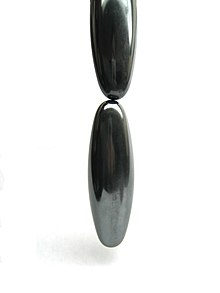
Rare earth (
Single-molecule magnets (SMMs) and single-chain magnets (SCMs)
In the 1990s, it was discovered that certain molecules containing paramagnetic metal ions are capable of storing a magnetic moment at very low temperatures. These are very different from conventional magnets that store information at a magnetic domain level and theoretically could provide a far denser storage medium than conventional magnets. In this direction, research on monolayers of SMMs is currently under way. Very briefly, the two main attributes of an SMM are:
- a large ground state spin value (S), which is provided by ferromagnetic or ferrimagnetic coupling between the paramagnetic metal centres
- a negative value of the anisotropy of the zero field splitting (D)
Most SMMs contain manganese but can also be found with vanadium, iron, nickel and cobalt clusters. More recently, it has been found that some chain systems can also display a magnetization that persists for long times at higher temperatures. These systems have been called single-chain magnets.
Nano-structured magnets
Some nano-structured materials exhibit energy waves, called magnons, that coalesce into a common ground state in the manner of a Bose–Einstein condensate.[37][38]
Rare-earth-free permanent magnets
The
Costs
The current[update] cheapest permanent magnets, allowing for field strengths, are flexible and ceramic magnets, but these are also among the weakest types. The ferrite magnets are mainly low-cost magnets since they are made from cheap raw materials: iron oxide and Ba- or Sr-carbonate. However, a new low cost magnet, Mn–Al alloy,[35][non-primary source needed][41] has been developed and is now dominating the low-cost magnets field.[citation needed] It has a higher saturation magnetization than the ferrite magnets. It also has more favorable temperature coefficients, although it can be thermally unstable. Neodymium–iron–boron (NIB) magnets are among the strongest. These cost more per kilogram than most other magnetic materials but, owing to their intense field, are smaller and cheaper in many applications.[42]
Temperature
Temperature sensitivity varies, but when a magnet is heated to a temperature known as the
Additionally, some magnets are brittle and can fracture at high temperatures.
The maximum usable temperature is highest for alnico magnets at over 540 °C (1,000 °F), around 300 °C (570 °F) for ferrite and SmCo, about 140 °C (280 °F) for NIB and lower for flexible ceramics, but the exact numbers depend on the grade of material.
Electromagnets
An electromagnet, in its simplest form, is a wire that has been coiled into one or more loops, known as a
If the coil of wire is wrapped around a material with no special magnetic properties (e.g., cardboard), it will tend to generate a very weak field. However, if it is wrapped around a soft ferromagnetic material, such as an iron nail, then the net field produced can result in a several hundred- to thousandfold increase of field strength.
Uses for electromagnets include particle accelerators, electric motors, junkyard cranes, and magnetic resonance imaging machines. Some applications involve configurations more than a simple magnetic dipole; for example, quadrupole and sextupole magnets are used to focus particle beams.
Units and calculations
For most engineering applications, MKS (rationalized) or
In all units, it is convenient to employ two types of magnetic field, B and H, as well as the magnetization M, defined as the magnetic moment per unit volume.
- The magnetic induction field B is given in SI units of teslas (T). B is the magnetic field whose time variation produces, by Faraday's Law, circulating electric fields (which the power companies sell). B also produces a deflection force on moving charged particles (as in TV tubes). The tesla is equivalent to the magnetic flux (in webers) per unit area (in meters squared), thus giving B the unit of a flux density. In CGS, the unit of B is the gauss (G). One tesla equals 104 G.
- The magnetic field H is given in SI units of ampere-turns per meter (A-turn/m). The turns appear because when H is produced by a current-carrying wire, its value is proportional to the number of turns of that wire. In CGS, the unit of H is the oersted (Oe). One A-turn/m equals 4π×10−3 Oe.
- The magnetization M is given in SI units of amperes per meter (A/m). In CGS, the unit of M is the oersted (Oe). One A/m equals 10−3 emu/cm3. A good permanent magnet can have a magnetization as large as a million amperes per meter.
- In SI units, the relation B = μ0(H + M) holds, where μ0 is the permeability of space, which equals 4π×10−7 T•m/A. In CGS, it is written as B = H + 4πM. (The pole approach gives μ0H in SI units. A μ0M term in SI must then supplement this μ0H to give the correct field within B, the magnet. It will agree with the field B calculated using Ampèrian currents).
Materials that are not permanent magnets usually satisfy the relation M = χH in SI, where χ is the (dimensionless) magnetic susceptibility. Most non-magnetic materials have a relatively small χ (on the order of a millionth), but soft magnets can have χ on the order of hundreds or thousands. For materials satisfying M = χH, we can also write B = μ0(1 + χ)H = μ0μrH = μH, where μr = 1 + χ is the (dimensionless) relative permeability and μ =μ0μr is the magnetic permeability. Both hard and soft magnets have a more complex, history-dependent, behavior described by what are called hysteresis loops, which give either B vs. H or M vs. H. In CGS, M = χH, but χSI = 4πχCGS, and μ = μr.
Caution: in part because there are not enough Roman and Greek symbols, there is no commonly agreed-upon symbol for magnetic pole strength and magnetic moment. The symbol m has been used for both pole strength (unit A•m, where here the upright m is for meter) and for magnetic moment (unit A•m2). The symbol μ has been used in some texts for magnetic permeability and in other texts for magnetic moment. We will use μ for magnetic permeability and m for magnetic moment. For pole strength, we will employ qm. For a bar magnet of cross-section A with uniform magnetization M along its axis, the pole strength is given by qm = MA, so that M can be thought of as a pole strength per unit area.
Fields of a magnet
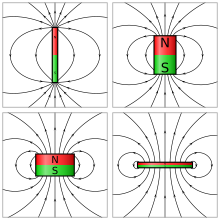
Far away from a magnet, the magnetic field created by that magnet is almost always described (to a good approximation) by a dipole field characterized by its total magnetic moment. This is true regardless of the shape of the magnet, so long as the magnetic moment is non-zero. One characteristic of a dipole field is that the strength of the field falls off inversely with the cube of the distance from the magnet's center.
Closer to the magnet, the magnetic field becomes more complicated and more dependent on the detailed shape and magnetization of the magnet. Formally, the field can be expressed as a multipole expansion: A dipole field, plus a quadrupole field, plus an octupole field, etc.
At close range, many different fields are possible. For example, for a long, skinny bar magnet with its north pole at one end and south pole at the other, the magnetic field near either end falls off inversely with the square of the distance from that pole.
Calculating the magnetic force
Pull force of a single magnet
The strength of a given magnet is sometimes given in terms of its pull force — its ability to pull
- ,
where
- F is force (SI unit: newton)
- A is the cross section of the area of the pole in square meters
- B is the magnetic induction exerted by the magnet
This result can be easily derived using Gilbert model, which assumes that the pole of magnet is charged with magnetic monopoles that induces the same in the ferromagnetic object.
If a magnet is acting vertically, it can lift a mass m in kilograms given by the simple equation:
where g is the gravitational acceleration.
Force between two magnetic poles
Classically, the force between two magnetic poles is given by:[47]
where
- F is force (SI unit: newton)
- qm1 and qm2 are the magnitudes of magnetic poles (SI unit: ampere-meter)
- μ is the meter per ampere, henry per meter or newton per ampere squared)
- r is the separation (SI unit: meter).
The pole description is useful to the engineers designing real-world magnets, but real magnets have a pole distribution more complex than a single north and south. Therefore, implementation of the pole idea is not simple. In some cases, one of the more complex formulae given below will be more useful.
Force between two nearby magnetized surfaces of area A
The mechanical force between two nearby magnetized surfaces can be calculated with the following equation. The equation is valid only for cases in which the effect of fringing is negligible and the volume of the air gap is much smaller than that of the magnetized material:[48][49]
where:
- A is the area of each surface, in m2
- H is their magnetizing field, in A/m
- μ0 is the permeability of space, which equals 4π×10−7 T•m/A
- B is the flux density, in T.
Force between two bar magnets
The force between two identical cylindrical bar magnets placed end to end at large distance is approximately:[dubious ],[48]
where:
- B0 is the magnetic flux density very close to each pole, in T,
- A is the area of each pole, in m2,
- L is the length of each magnet, in m,
- R is the radius of each magnet, in m, and
- z is the separation between the two magnets, in m.
- relates the flux density at the pole to the magnetization of the magnet.
Note that all these formulations are based on Gilbert's model, which is usable in relatively great distances. In other models (e.g., Ampère's model), a more complicated formulation is used that sometimes cannot be solved analytically. In these cases,
Force between two cylindrical magnets
For two cylindrical magnets with radius and length , with their magnetic dipole aligned, the force can be asymptotically approximated at large distance by,[50]
where is the magnetization of the magnets and is the gap between the magnets. A measurement of the magnetic flux density very close to the magnet is related to approximately by the formula
The effective magnetic dipole can be written as
Where is the volume of the magnet. For a cylinder, this is .
When , the point dipole approximation is obtained,
which matches the expression of the force between two magnetic dipoles.
See also
Notes
- ^ Platonis Opera Archived 2018-01-14 at the Wayback Machine, Meyer and Zeller, 1839, p. 989.
- ^ The location of Magnesia is debated; it could be the region in mainland Greece or Magnesia ad Sipylum. See, for example, "Magnet". Language Hat blog. 28 May 2005. Archived from the original on 19 May 2012. Retrieved 22 March 2013.
- ^ Fowler, Michael (1997). "Historical Beginnings of Theories of Electricity and Magnetism". Archived from the original on 2008-03-15. Retrieved 2008-04-02.
- S2CID 143949193.
- S2CID 143585290.
- ^ Pliny the Elder, The Natural History, BOOK XXXIV. THE NATURAL HISTORY OF METALS., CHAP. 42.—THE METAL CALLED LIVE IRON Archived 2011-06-29 at the Wayback Machine. Perseus.tufts.edu. Retrieved on 2011-05-17.
- ^ OCLC 664016090.
- ^ "Four Great Inventions of Ancient China". Embassy of the People's Republic of China in the Republic of South Africa. 2004-12-13. Retrieved January 8, 2023.
- (PDF) from the original on 2012-05-24.
- ^ "The Seven Magnetic Moments - Modern Magnets". Trinity College Dublin. Retrieved January 8, 2023.
- S2CID 244736617, retrieved 2023-01-08
- ^ "Joseph Henry – Engineering Hall of Fame". Edison Tech Center. Retrieved January 8, 2023.
- OCLC 40251748.
- ^ Knight, Jones, & Field, "College Physics" (2007) p. 815.
- ISBN 978-0-471-47741-9.
- doi:10.1119/1.15501.
- ^ "Units for Magnetic Properties" (PDF). Lake Shore Cryotronics, Inc. Archived from the original (PDF) on 2011-07-14. Retrieved 2012-11-05.
- ^ Allen, Zachariah (1852). Philosophy of the Mechanics of Nature, and the Source and Modes of Action of Natural Motive-Power. D. Appleton and Company. p. 252.
- ISBN 978-0-12-619455-5. Archivedfrom the original on 2014-06-27.
- ISBN 0-495-10619-4. Archivedfrom the original on 2013-06-04.
- ISBN 0-521-40949-7. Archivedfrom the original on 2016-12-24.
- ISBN 0-7503-0718-8. Archivedfrom the original on 2016-12-24.
- ^ a b Nave, Carl R. (2010). "Bar Magnet". Hyperphysics. Dept. of Physics and Astronomy, Georgia State Univ. Archived from the original on 2011-04-08. Retrieved 2011-04-10.
- ^ Mice levitated in NASA lab Archived 2011-02-09 at the Wayback Machine. Livescience.com (2009-09-09). Retrieved on 2011-10-08.
- ISBN 0-12-466626-4.
- ^ "The stripe on a credit card". How Stuff Works. Archived from the original on 2011-06-24. Retrieved 19 July 2011.
- ^ "Electromagnetic deflection in a cathode ray tube, I". National High Magnetic Field Laboratory. Archived from the original on 3 April 2012. Retrieved 20 July 2011.
- ^ "Snacks about magnetism". The Exploratorium Science Snacks. Exploratorium. Archived from the original on 7 April 2013. Retrieved 17 April 2013.
- ^ "Neodymium Magnets : Strength, design for tramp metal removal". Archived from the original on 2017-05-10. Retrieved 2016-12-05. Source on magnets in process industries
- S2CID 19976829.
- S2CID 21306900.
- ^ McKenzie, A. E. E. (1961). Magnetism and electricity. Cambridge. pp. 3–4.
- ^ "Ferromagnetic Materials". Phares Electronics. Archived from the original on 27 June 2015. Retrieved 26 June 2015.
- ISBN 0-07-136076-X. Archivedfrom the original on 2016-12-24.
- ^ a b c "Nanostructured Mn-Al Permanent Magnets (patent)". Retrieved 18 Feb 2017.
- ^ "Press release: Fridge magnet transformed". Riken. March 11, 2011. Archived from the original on August 7, 2017.
- ^ "Nanomagnets Bend The Rules". Archived from the original on December 7, 2005. Retrieved November 14, 2005.
- PMID 15904108.
- ^ "Research Funding for Rare Earth Free Permanent Magnets". ARPA-E. Archived from the original on 10 October 2013. Retrieved 23 April 2013.
- ^ By (2022-09-01). "Iron Nitrides: Powerful Magnets Without The Rare Earth Elements". Hackaday. Retrieved 2023-11-08.
- ^ An Overview of MnAl Permanent Magnets with a Study on Their Potential in Electrical Machines
- ^ Frequently Asked Questions Archived 2008-03-12 at the Wayback Machine. Magnet sales & Mfct Co Inc. Retrieved on 2011-10-08.
- ISBN 978-1-4292-0410-1.
- ^ "How Much Will a Magnet Hold?". www.kjmagnetics.com. Retrieved 2020-01-20.
- ^ "Magnetic Pull Force Explained - What is Magnet Pull Force? | Dura Magnetics USA". 19 October 2016. Retrieved 2020-01-20.
- ISBN 9781846286681. Archivedfrom the original on 2016-12-24.
- ^ "Basic Relationships". Geophysics.ou.edu. Archived from the original on 2010-07-09. Retrieved 2009-10-19.
- ^ a b "Magnetic Fields and Forces". Archived from the original on 2012-02-20. Retrieved 2009-12-24.
- ^ "The force produced by a magnetic field". Archived from the original on 2010-03-17. Retrieved 2010-03-09.
- .
References
- "The Early History of the Permanent Magnet". Edward Neville Da Costa Andrade, Endeavour, Volume 17, Number 65, January 1958. Contains an excellent description of early methods of producing permanent magnets.
- "positive pole n". The Concise Oxford English Dictionary. Catherine Soanes and Angus Stevenson. Oxford University Press, 2004. Oxford Reference Online. Oxford University Press.
- Wayne M. Saslow, Electricity, Magnetism, and Light, Academic (2002). ISBN 0-12-619455-6. Chapter 9 discusses magnets and their magnetic fields using the concept of magnetic poles, but it also gives evidence that magnetic poles do not really exist in ordinary matter. Chapters 10 and 11, following what appears to be a 19th-century approach, use the pole concept to obtain the laws describing the magnetism of electric currents.
- Edward P. Furlani, Permanent Magnet and Electromechanical Devices:Materials, Analysis and Applications, Academic Press Series in Electromagnetism (2001). ISBN 0-12-269951-3.
External links
- How magnets are made Archived 2013-03-16 at the Wayback Machine (video)
- Floating Ring Magnets, Bulletin of the IAPT, Volume 4, No. 6, 145 (June 2012). (Publication of the Indian Association of Physics Teachers).
- A brief history of electricity and magnetism






![{\displaystyle F\simeq \left[{\frac {B_{0}^{2}A^{2}\left(L^{2}+R^{2}\right)}{\pi \mu _{0}L^{2}}}\right]\left[{\frac {1}{z^{2}}}+{\frac {1}{(z+2L)^{2}}}-{\frac {2}{(z+L)^{2}}}\right]}](https://wikimedia.org/api/rest_v1/media/math/render/svg/92025ea3ce20ac6022e6d9c4677bde62daf6764e)



![{\displaystyle F(z)\simeq {\frac {\pi \mu _{0}}{4}}M^{2}R^{4}\left[{\frac {1}{z^{2}}}+{\frac {1}{(z+2L)^{2}}}-{\frac {2}{(z+L)^{2}}}\right]}](https://wikimedia.org/api/rest_v1/media/math/render/svg/02185a720de327d3e9296e2678217ceef559a2cc)








